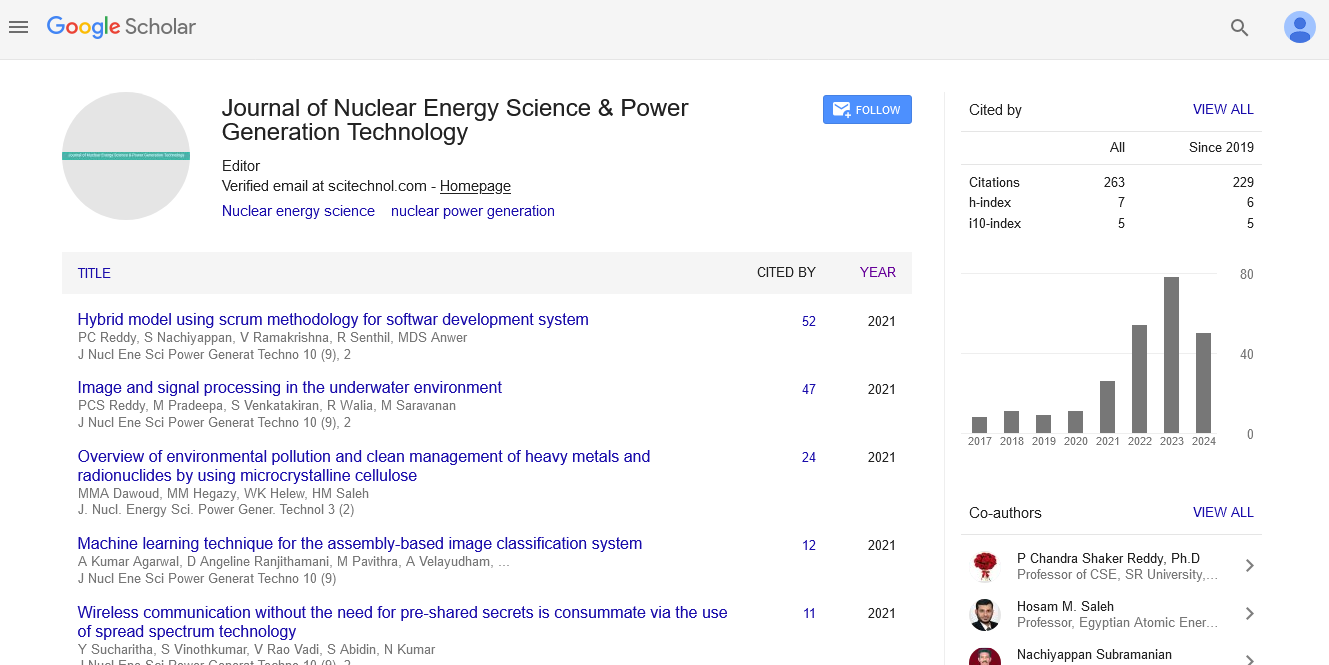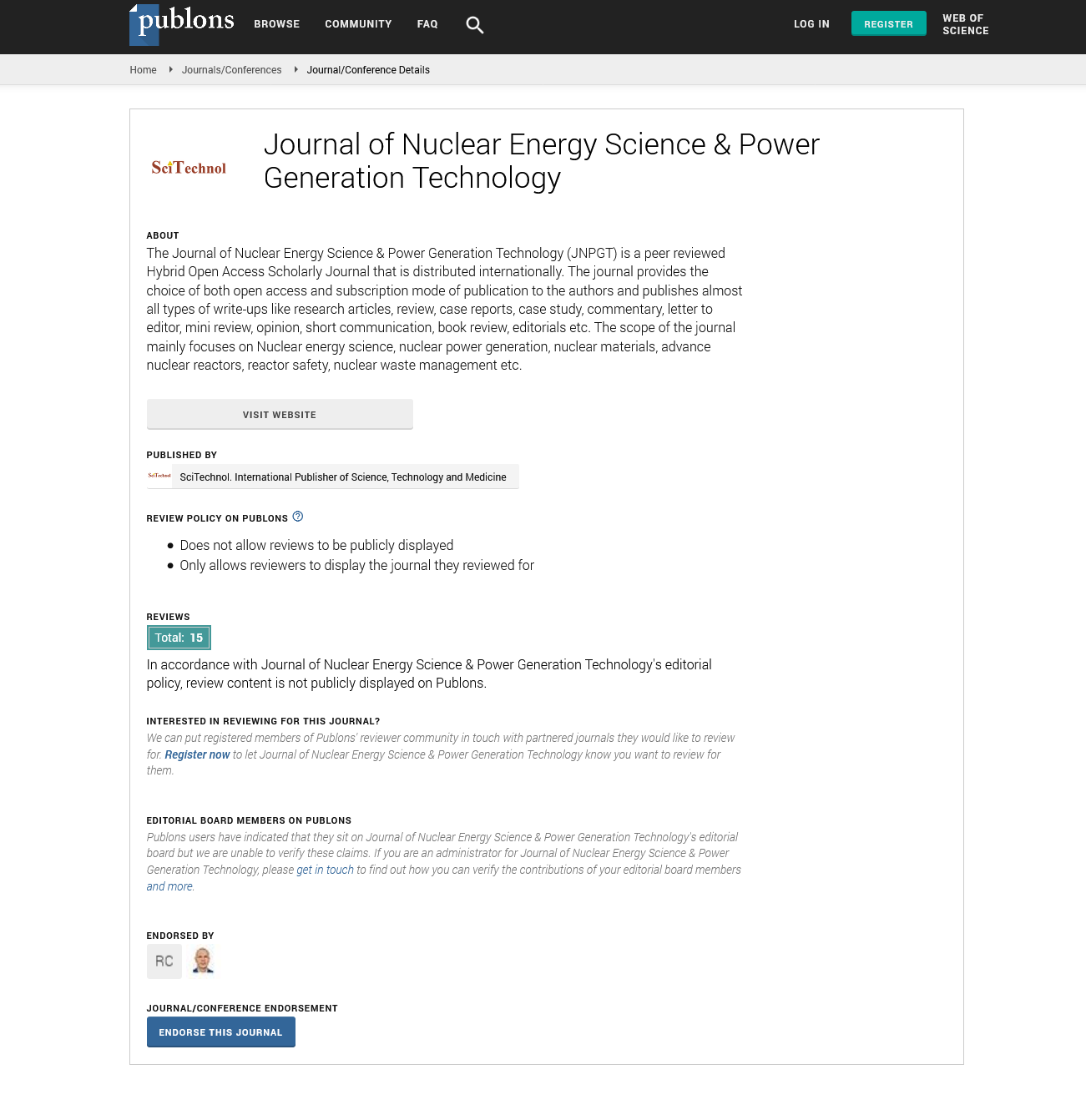Perspective, J Nucl Ene Sci Power Generat Technol Vol: 13 Issue: 5
Maximizing Energy Efficiency in Modern Hydroelectric Power Plants
Seria Linmi*
1Department of Energy and Environment, Chalmers University of Technology, Gothenburg, Sweden
*Corresponding Author: Seria Linmi,
Department of Energy and Environment,
Chalmers University of Technology, Gothenburg, Sweden
E-mail: seria_linmi78@gmail.com
Received date: 26 August, 2024, Manuscript No. JNPGT-24-150418;
Editor assigned date: 28 August, 2024, PreQC No. JNPGT-24-150418 (PQ);
Reviewed date: 11 September, 2024, QC No. JNPGT-24-150418;
Revised date: 18 September, 2024, Manuscript No. JNPGT-24-150418 (R);
Published date: 25 September, 2024, DOI: 10.4172/2325-9809.1000421.
Citation: Linmi S (2024) Maximizing Energy Efficiency in Modern Hydroelectric Power Plants. J Nucl Ene Sci Power Generat Technol 13:5.
Description
Hydroelectric power, often referred to as hydropower is one of the most reliable and efficient renewable energy sources in the world today. By connecting the energy of flowing water, hydroelectric power plants generate electricity with minimal environmental impact compared to fossil fuel-based energy. As countries around the globe aim to reduce greenhouse gas emissions and transition toward cleaner energy, hydropower is playing an important role in the energy mix. Hydroelectric power is generated through the movement of water, typically from a river or a dam. The basic principle of hydropower is converting the potential energy stored in elevated water into mechanical energy, which then turns turbines to produce electricity. These depend on the natural flow of a river and typically do not require large dams. They generate electricity based on the river’s current flow, making them less disruptive to local ecosystems. These are the most common type of hydroelectric plants. They store water in a reservoir, usually behind a dam and release it to generate electricity when needed. This allows for better control over energy production and water management. These plants store energy by pumping water from a lower reservoir to a higher one during low demand periods. During peak demand, the stored water is released back down to generate electricity. Pumped storage acts as a large-scale energy storage solution, helping to balance supply and demand in power grids.
Advantages of hydroelectric power
One of the major advantages of hydroelectric power is its renewability. Since water is continuously replenished through the natural water cycle, hydropower plants can operate indefinitely without depleting resources. This contrasts sharply with fossil fuels, which are finite and cause environmental degradation when extracted and burned. Hydropower is also highly efficient. The energy conversion process in modern hydroelectric power plants can achieve efficiency rates as high as 90% significantly higher than fossil fuelbased power plants which average around 40%-60%. This efficiency contributes to hydropower’s cost-effectiveness, as less energy is lost in the conversion process. In addition, hydroelectric plants can provide flexibility in electricity generation. Operators can quickly adjust the water flow through turbines to meet changes in electricity demand. This ability to ramp production up or down makes hydropower an ideal complement to other renewable energy sources like solar and wind which are more intermittent. There are also social implications, as large hydroelectric projects can displace communities living in areas designated for dam construction. Proper planning, community engagement and modification strategies are essential to ensure that hydropower development is socially equitable.
Conclusion
Despite these challenges, hydroelectric power remains a basis of the global transition to renewable energy. With climate change becoming an ever-increasing concern, the need for reliable, low-emission energy sources are more dangerous. Hydroelectric power provides a way to generate large amounts of electricity without contributing to greenhouse gas emissions, making it a key role in reducing our reliance on fossil fuels. Furthermore, advancements in small-scale hydropower technologies and innovations like river systems are helping to moderate some of the environmental and social impacts of traditional dam-based systems. These technologies provide more localized and less disruptive options for communities looking to benefit from renewable energy. In conclusion, hydroelectric power provides an essential solution to the global energy crisis. By balancing its benefits with careful consideration of its environmental and social impacts, hydropower can continue to be a vital part of the world’s shift toward a sustainable, low-carbon future. Through improved technology and responsible planning, it has the potential to provide clean, efficient and reliable energy for generations to come.
 Spanish
Spanish  Chinese
Chinese  Russian
Russian  German
German  French
French  Japanese
Japanese  Portuguese
Portuguese  Hindi
Hindi 

